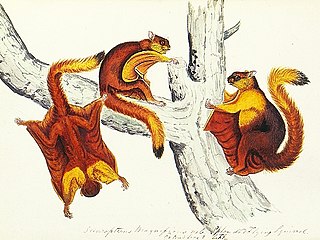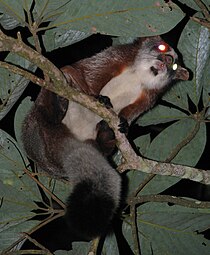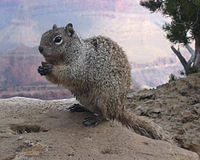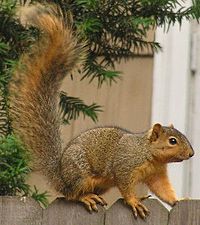
Flying squirrels are a tribe of 50 species of squirrels in the family Sciuridae. Despite their name, they are not in fact capable of full flight in the same way as birds or bats, but they are able to glide from one tree to another with the aid of a patagium, a furred parachute-like skin membrane that stretches from wrist to ankle. Their long tails also provide stability as they glide. Anatomically they are very similar to other squirrels with a number of adaptations to suit their lifestyle; their limb bones are longer and their hand bones, foot bones, and distal vertebrae are shorter. Flying squirrels are able to steer and exert control over their glide path with their limbs and tail.

Sciurinae is a subfamily of squirrels, uniting the flying squirrels with certain related tree squirrels. Older sources place the flying squirrels in a separate subfamily (Pteromyinae) and unite all remaining sciurids into the subfamily Sciurinae, but this has been strongly refuted by genetic studies.

Eupetaurus is a genus of rodent in the family Sciuridae. Members of this genus are known as woolly flying squirrels. They are large to very large flying squirrels found in the highest rocky cliffs near the treeline of the Himalayas and Tibetan Plateau. Due to the inaccessibility of their montane habitat, they are difficult to study.

Large black flying squirrel form a taxon of squirrels under the tribe Pteromyini. They are only found in South-east Asia.

Biswamoyopterus is a genus of rodent in the family Sciuridae. It contains three known species of very large flying squirrels, with B. laoensis being among the longest of all squirrels. They are distributed in forests in northeast India, southwest China and Laos. Despite their size, species in this genus tend to be very elusive; due to this, all of them have been described relatively recently. Additionally, they are easily confused with certain Petaurista giant flying squirrels that are more common and overlap in range with the rare Biswamoyopterus.

The Namdapha flying squirrel is an arboreal, nocturnal flying squirrel endemic to Arunachal Pradesh in northeast India, where it is known from a single specimen collected in Namdapha National Park in 1981. No population estimate is available for B. biswasi, but the known habitat is tall Mesua ferrea jungles, often on hill slopes in the catchment area of Dihing River in northeastern India.

The red giant flying squirrel or common giant flying squirrel is a species of rodent in the family Sciuridae (squirrels). It is found in a wide variety of forest–types, plantations and more open habitats with scattered trees in Southeast Asia, ranging north to the Himalayas and southern and central China. One of the largest arboreal squirrels, all populations have at least some reddish-brown above and pale underparts, but otherwise there are significant geographic variations in the colours. The taxonomic position of those in the Sundaic region is generally agreed upon, but there is considerable uncertainty about the others, which variously have been included in this or other species, or recognized as their own species.
The Kashmir flying squirrel is a species of rodent in the family Sciuridae. It is monotypic within the genus Eoglaucomys. It is found in Afghanistan, India and Pakistan. Its natural habitat is subtropical or tropical dry forests. It is threatened by habitat loss. The Afghan flying squirrel is usually considered a subspecies.

The particolored flying squirrel is a species of rodent in the family Sciuridae. It is found in Bangladesh, Bhutan, Cambodia, China, India, Laos, Myanmar, Nepal, Thailand, and Vietnam. Its natural habitat is subtropical or tropical dry forests. It is threatened by habitat loss.

The red and white giant flying squirrel is a species of rodent in the family Sciuridae. It is a very large, dark rufous-red, buff and white flying squirrel found in forests at altitudes of 800–3,500 m (2,600–11,500 ft) in mainland China and 1,200–3,750 m (3,940–12,300 ft) in Taiwan, although the population of the latter island is distinctive and likely better regarded as a separate species, the Taiwan giant flying squirrel. Additionally, the red and white giant flying squirrel possibly ranges into northeastern South Asia and far northern Mainland Southeast Asia. This squirrel has a wide range and is relatively common, and the International Union for Conservation of Nature lists it as being of "least concern".

Petaurista is a genus of rodent in the family Sciuridae. They are large to very large flying squirrels found in forests and other wooded habitats in southern and eastern Asia.

Hodgson's giant flying squirrel is a species of rodent in the family Sciuridae. This large flying squirrel lives in Himalayan forests in Asia. Like other flying squirrels, it is nocturnal and able to glide long distances between trees by spreading out its patagium, skin between its limbs.

The Bhutan giant flying squirrel, also known as the Gray's giant flying squirrel or noble giant flying squirrel, is a species of rodent in the family Sciuridae. This species lives in Himalayan forests and it is one of the largest flying squirrels. Like other flying squirrels, it is mainly nocturnal and able to glide long distances between trees by spreading out its patagium, skin between its limbs.

The Indian giant flying squirrel, also called the large brown flying squirrel or the common giant flying squirrel, is a species of rodent in the family Sciuridae. It is capable of gliding flight using a skin membrane stretched between front and hind legs. It is found in mainland Southeast and South Asia, and southern and central China.

Vladimir Dinets is a Russian zoologist and mathematician, known for his studies of Crocodilian behavior and of numerous rare animals in remote parts of the world, as well as for popular writings in Russian and English.
The Mount Gaoligong flying squirrel is a species of large, arboreal flying squirrel endemic to highland forests in southwestern China.
The Gurez National Park, also known as Musk Deer National Park, is one of the protected areas of Pakistan. It is located in Neelum District in Azad kashmir, Pakistan, besides the Neelum River in the Gurez valley. It is located in the high Himalayas and Pir Panjal Range. It is a thirty-five minute drive from Gurez tehsil. It is also known as Gurez valley national park.
The Tibetan woolly flying squirrel is a species of very large flying squirrel in the genus Eupetaurus. It is found in the south-central portion of the Tibetan Plateau, namely south-central Tibet, northern Sikkim, and western Bhutan.
The Yunnan woolly flying squirrel is a species of very large flying squirrel in the genus Eupetaurus. It is found on the southeastern margin of the Himalayas, namely in northwestern Yunnan and potentially Myanmar.
The Hainan flying squirrel is a species of rodent in the family Sciuridae. It is endemic to Hainan Island in China.





















